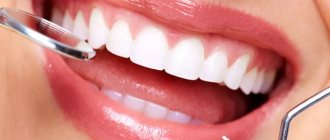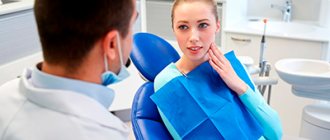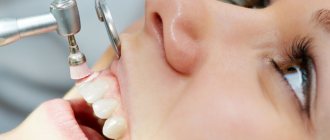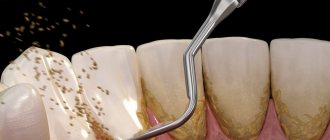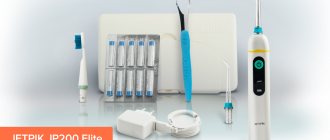- Causes of gum sensitivity Vigorously brushing teeth
- Changes in hormone levels
- Irritation from dental plaque
- Gingivitis
- Toothpastes
When inflammatory processes occur, the gums become red, itchy, and swollen.
Many people believe that these symptoms will go away over time and think that everything is fine. But if you start the problem of gum sensitivity, you can face more serious consequences. We tell you how to deal with sensitive gums at home, when to go to the dentist and what to choose for daily care.
Causes of gum sensitivity
The most common reasons include signs of disease and characteristics of the body or brushing teeth. Let's highlight the three most popular reasons.
Vigorous teeth brushing
Many people believe that in order to get a good cleaning, you need to press harder on the brush. And it’s even better if this brush has stiff bristles and the abrasiveness index of the paste is maximum. But if you are prone to sensitivity, this approach is especially harmful.
For thorough cleaning, soft bristles and low-abrasive paste are sufficient. And the cleaning technique does not have to be intensive. We wrote more about the techniques in the article “How to properly brush your teeth with a manual brush.”
Changes in hormone levels
Increased sensitivity of the gums is often observed in diseases of the endocrine and nervous systems, as well as in women during pregnancy. Changes in hormone levels lead to a deterioration in the blood supply to the mucous membrane. In addition, the number of bacteria in the oral cavity increases, and the enamel does not receive enough minerals.
Irritation from dental plaque
Irritation of dentin tissue is natural during the formation of dental plaque - a formation that can create an acidic environment in the oral cavity. Plaque is a mixture of bacteria, food debris, saliva and mucus with calcium and phosphate salts.
Poor hygiene leads to plaque accumulation, which pushes the gum away from the tooth. This causes redness and irritation of the gums. And subsequently gingivitis and even periodontitis.
Improper brushing of teeth
Let's admit it, we brush our teeth automatically. And we often do it wrong: we clean them with movements left and right, sherk-sherk. With this method of cleaning, soft plaque is transferred from the surface of the teeth to the interdental spaces and becomes clogged there. As a result, there is a danger of gum damage and the appearance of a wedge-shaped defect, especially on protruding teeth. A wedge-shaped defect is a lesion of a tooth in the area of contact with the gum. It looks like a step that resembles a wedge. The dimensions can range from barely noticeable to complete chipping in the future.
See what happens when we brush our teeth across their growth:
Types of inflammatory gum diseases
We looked at the reasons that are not related to diseases. Now let's talk about what types of inflammations you should go to the doctor for. These include the three most common diseases: gingivitis, periodontitis and periodontal disease. Let's look at each of them in more detail.
Gingivitis
Gingivitis is an inflammation of the dentin tissue around a specific tooth. It occurs in both chronic and acute forms. The inflammatory process manifests itself only on the gums, without affecting the tooth tissue. Therefore, it is quite simple to cope with gingivitis before it progresses to the stage of periodontitis.
Periodontitis
Periodontitis is the inflammation of the tooth tissues that support it. This tissue is located between the root of the tooth and the jaw bone. The disease gradually moves the gum away from the tooth, forming a gum pocket. In other words, the gums expose the teeth, and they become sensitive. Food gets clogged into the gum pockets, pus appears in the acute phase, and the teeth gradually become loose and shift.
Inflammatory diseases are easy to distinguish by visual examination: with gingivitis - only redness and swelling, with periodontitis - also receding gums
Assistive methods for brushing with a toothbrush
Fones method
It belongs to the American dentist Alfred Fones, who is considered one of the founders of hygienic dentistry. The method is suitable for adults, children and people who do not have periodontal disease.
- To clean the external surfaces, the teeth are closed and the bristles of the brush are placed perpendicular to the surface. The brush head makes circles while simultaneously capturing the teeth of both jaws and the adjacent gums.
- The same movements are performed to clean the internal surfaces (separately for the upper and lower jaws).
- Chewing surfaces are also cleaned using circular movements.
Pros:
good gum massage.
Bass method
The method involves cleaning and massaging the gums with vibrating movements, and cleaning the chewing surfaces with horizontal movements. Advantages:
The method is suitable for cleaning teeth with exposed roots. You can only use a soft brush.
What symptoms indicate inflammatory processes?
We have looked at the main reasons why gums become inflamed and bleed. But how to deal with the symptoms? What exactly indicates the disease until the gums begin to bleed and become swollen?
In addition to insufficient oral hygiene, inflammation can be caused by untimely treatment of pulpitis, the formation of tartar along the gum line, as well as fillings and crowns with an overhanging edge.
Symptoms include:
- pain when pressed or touched;
- bad breath;
- itching and redness around the tooth;
- discomfort when biting food;
- loosening of teeth.
Are electric toothbrushes dangerous?
Another study found that electric brushes were more likely than manual brushes to wear away dentin, the layer under the tooth enamel. Wearing dentin increases tooth sensitivity and can increase the risk of developing tooth decay. However, experts say that brushing too hard with any toothbrush can increase the chance of damaging tooth enamel. However, this is especially important to remember when using electric brushes, because you do not need to make any movements, because the rotating or vibrating head does all the work for you.
Treatment and care for sensitive gums
Inflammatory gum diseases in adults and children do not arise out of nowhere. Sometimes it can take from 1.5 to 15 years for serious consequences to occur. But the first symptoms of inflammation, which we have already described, signal that it is worth at least choosing the necessary care and taking preventive measures.
In this section we will talk about products for daily care for bleeding and inflammation of the gums.
Toothpastes
Regardless of the cause of the bleeding, the first thing to look at is your toothpaste. During exacerbations, it needs to be changed to one that heals the mucous membrane and relieves inflammation.
To relieve gum sensitivity, choose pastes containing chlorhexidine, plant extracts (oak bark, sage, chamomile), allantoin, and essential oils (menthol, thymol). To pair with the paste, choose a brush with soft bristles. And don't forget to change it every 3 months. Complete your care with a rinse for sensitive gums.
Often, for gum inflammation, dentists recommend three types of pastes.
- With chlorhexidine - relieve inflammation and swelling, help restore soft tissue.
- With antioxidants - reduce pain, improve blood circulation in the gums.
- With herbs - protect soft tissues from irritation, help in the healing of ulcers, erosions and open wounds.
Apadent Perio toothpaste (90 gr)
Toothpaste Biorepair Gum Protection Gum Protection 75 ml
Dentissimo PRO-care toothpaste Protecting teeth and gums
Dentaid Perio-Aid tooth gel paste with chlorhexidine 0.12%
Rinse aids
To rinse sensitive gums, you should choose anti-inflammatory balms and rinses. They contain substances necessary to relieve inflammation and prevent the proliferation of pathogenic bacteria:
- amino acids;
- xylitol;
- chlorhexidine;
- hydroxyapatite and other components.
Dentaid Perio-aid Active control with chlorhexidine 0.05%
Waterdent mouthwash Chlorhexidine
Anti-inflammatory balm Vivax
Biorepair Mouthwash Gum Protection 500 ml
These balms can also be used to rinse sensitive gums after tooth extraction.
Local treatment: ointments, gels, collagen plates
Local treatment agents have a pronounced hemostatic, anti-inflammatory and healing effect. By applying the gel or plate to the site of inflammation, you will get a positive result the very next day. In the composition of the products you will find everything you need for healing and relieving inflammation:
- chlorhexidine;
- herbal extracts;
- amino acid complexes;
- biooxidants;
- collagens.
Farmadont II collagen plates for painful and sensitive gums...
Elugel gum gel
Tooth gel Pierre Fabre Parodium
Vivax anti-inflammatory tooth gel
Briefly about professional help
We've sorted out the home care products. Now we’ll tell you how gum sensitivity is treated and cared for in the dentist’s office. The choice of care depends on the degree of neglect and symptoms. In some cases, hygienic cleaning is necessary, and in case of serious consequences, physical therapy and a visit to a dental surgeon cannot be avoided.
- Ultrasonic hygienic cleaning allows you to remove plaque, microbial film and hard deposits without harming inflamed gums. This method has contraindications: asthma, heart failure, diabetes, postoperative period.
- Physiotherapy is an additional method for anti-inflammatory local therapy, which is most effective at the stages of gingivitis and periodontitis. Physiotherapy includes darsonvalization (microcurrent), massage and vacuum therapy. These types of treatments are aimed at strengthening dentin tissue.
- Surgical intervention is a last resort in the treatment of inflammatory processes of the gums. They resort to it when a person develops dental pockets and the tooth becomes very loose.
How to brush your teeth correctly?
It is a mistaken idea that everyone can do this. There are a number of rules, many of which are either unknown or ignored. However, only compliance with them guarantees effective cleaning of the enamel: • Carrying out hygiene procedures not only at home, but also at the dentist. • Rational selection of brushes and paste. • Using the optimal teeth brushing method. • Using dental floss, brushes and mouthwash. • Taking into account the condition of the gums, the presence of braces and dentures. • Compliance with the rules for storing, cleaning and replacing brushes.
Tablets for determining plaque will help you understand whether you have achieved your goal. They demonstrate whether unwanted deposits are present on the enamel. They also suggest which areas are not being worked through carefully enough.
Prevention of gum inflammation
Unpleasant symptoms of inflammatory processes can be avoided. With proper prevention and in the absence of diseases, it is enough to follow basic measures.
- Brush your teeth thoroughly every day with a manual or electric brush for sensitive gums, use dental floss and an irrigator.
- Create a balanced diet - do not abuse sweets, flour and sour foods, increase the amount of vegetables and fruits.
- To refuse from bad habits.
- Using rinses and balms will reduce the number of pathogenic bacteria in the mouth.
- Visit the dentist regularly, at least once every 6 months.
Advantages
- Efficiency. Waterpik interdental irrigators clean plaque much better than floss (dental floss).
- Fast process. Standard cleaning takes no more than 30 seconds.
- Easy to use. The guide tip ensures the correct angle of water flow.
- Ergonomics. The handle of the device fits comfortably in your hand. There is a pause button on it.
- Developing healthy habits. This is a simple and affordable way to improve the quality of interdental cleaning.
- Prevention. The Waterpik irrigator helps prevent caries and improves the condition of the gums.
Universal tips for choosing a toothbrush
Both electric and manual toothbrushes come with different sized heads and different bristle configurations. Some studies have found that pointed or curved bristles are slightly more effective at removing plaque than flat brushes. If you choose a manual or electric toothbrush, choose one with soft bristles—bristles that are too hard are more likely to cause damage to your gums and enamel. To further protect your teeth while brushing, make sure the bristles on the toothbrush you choose have rounded tips.
If you are set on purchasing an electric toothbrush, pay attention to the two-minute timer. Research shows that most people brush their teeth for only about 45 seconds on average, so a timer may encourage you to brush longer. Some models also have timers that go off every 30 seconds to remind you to move to a different area of your mouth.
The best toothbrush head should allow easy access to all surfaces of the teeth and is usually small. Although there are larger toothbrush heads available, you may find that they are difficult to maneuver to clean certain hard-to-reach areas, such as the sides and backs of molars. The toothbrush should have a long enough handle so that you can hold it comfortably in your hand.

